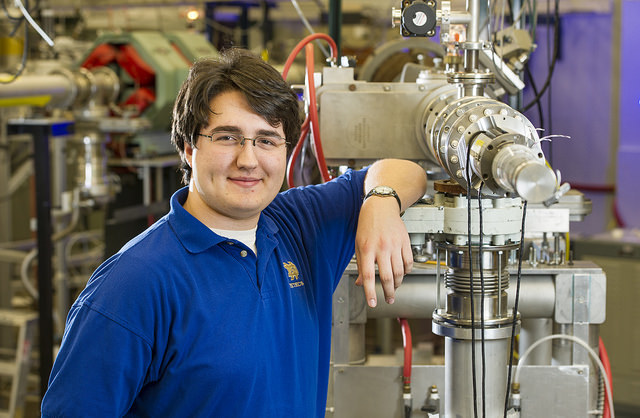
Patrick Fasano, a senior living in Morrissey Manor, began his journey into a world filled with Doppler-shifts, de-exciting recoiling nuclei, precision capacitance, circuits and plunger techniques well before most undergraduates even declare a major.
Growing up with a professor as a father, Fasano knew from a young age that he would one day also enter the expansive and exciting field of research. Fasano allowed no time to be lost and began his research as a senior in high school, where he studied biochemistry/health physics with Professor Laura Moore at Monmouth College, located in his hometown of Monmouth, IL.
After this successful year of physics-based research, Fasano’s desire to become involved with research during his undergraduate years was confirmed. Despite applying to eighteen schools, Notre Dame was an obvious choice for Fasano after visiting for the Reilly Visitation Weekend. In the short time that Fasano was on campus for this visitation, he had already started checking out potential research opportunities.
Fasano originally applied to Notre Dame as a computer engineering major. However, the strict course requirements for an engineering major deterred him away and instead brought him to the idea of pursuing a major in physics, a decision he never regretted.
During his freshman year, Fasano found a fitting position for himself in the laboratory of Professor Ani Aprahamian, a Nuclear Science Laboratory focused on experimental nuclear physics, where he completed a significant amount of her programming work. In addition to working with Professor Aprahamian, Fasano works with Professor Wanpeng Tan, graduate student Mallory Smith and a fellow undergraduate student Trenton Kuta.
His expertise and hard work in the laboratory allowed his relationship with Professor Aprahmian to blossom quickly. Professor Aprahamian helped Fasano find himself a position in a highly prestigious internship at the Yerevan Physics Insititute in Yerevan, Armenia the summer following his freshman year. Yerevan Physics Institute is a national laboratory that has distinctive expertise and insights in the fields of high energy physics and astrophysics, nuclear physics, scientific instrumentations and multivariate data analyses, as well as education. The mission of this institute aims to inject a spirit of enterprise into education and research within a dynamic “no-walls” environment. This focus on high impact research was certainly instilled in Fasano during his time at the Institute. He returned sophomore year excited to continue his work with Professor Aprahamian. Instead of continuing the pre-assigned work for her, however, he started to develop his own research project.
After reading copious amounts of research and educating himself on the technicalities of his work, Fasano began his current independent research project which involves the study of modernizing plunger control with low-cost digital electronics. The Notre Dame Nuclear Science Laboratory has a plunger device which is approximately 30 years old. Fasano’s work includes the upgrade and full rebuilding of the electronics to control the plunger system, participating in two major advances in this system. With the aid of his contributions, there is now a newly-applied precision capacitance-measuring circuit based on the phase-shift of a sinusoidal signal and there is also a low-cost microcontroller-based feedback loop that allows for precise controlled servo motors with quadrature encoder outputs. The microcontrollers are a significant modernization to the plunger system. These advances will be used in the future to measure the lifetimes of excited states in several rare earth nuclei.
In addition to the technical work that is involved with this work, Fasano also notes that a majority of his time is spent working on other tasks that are less involved yet are still equally important to his research. Fasano explains, “When you’re doing research, most of your time is not spent doing what you’d expect; you spend a lot of time debugging code, ordering parts, designing random mechanical pieces, etc. Probably 80% of your time is spent doing things that don’t seem like 'science,' but they are necessary pre-requisites to doing science.”
Today, Fasano continues to work through both scientific and non-scientific technicalities as he continues to work on programming and CAD (computer assisted design) for building parts and electron circuits. Each day that Fasano is in the lab, he is immersed in new ideas, new questions, and difficult roadblocks that he must overcome. A recent peculiar lab experience involved the development of a vacuum. Fasano laughs while reflecting, “Let me tell you, if you want to test whether or not a part will hold vacuum, you need to make sure all the pieces are put together. If you can see through the hole, its not airtight!”
As Fasano wraps up his time here at Notre Dame, he is beginning to look at where his future in research will lead him. He is planning on attending graduate school in physics. He would like to stay in academia following graduate school, but he rests easy for now with an incomplete response to this question because as he puts it, “that’s a long way off!”
